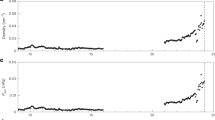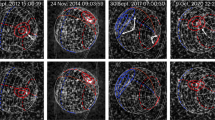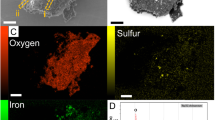Abstract
Desch and Kaiser1 have formulated a radiometric Bode's law from which they have attempted to estimate the low frequency, non-thermal radio power of Uranus' magnetosphere likely to be measured by the Voyager 2 spacecraft as a function of the planet's magnetic moment and the solar wind power input. They have in essence calculated what are possible necessary conditions for the generation of radio emission from Uranus. A potential problem arising from this calculation is that although their model for uranian radio emission may represent necessary conditions, they are not sufficient. I show here that, if Uranus possesses a magnetosphere, it is more likely that the radio emission is from the nightside as opposed to the dayside as assumed by Desch and Kaiser. A nightside source for the radio emissions would radically alter the predicted time for first observations of the emissions.
This is a preview of subscription content, access via your institution
Access options
Subscribe to this journal
Receive 51 print issues and online access
$199.00 per year
only $3.90 per issue
Buy this article
- Purchase on SpringerLink
- Instant access to full article PDF
Prices may be subject to local taxes which are calculated during checkout
Similar content being viewed by others
References
Desch, M. D. & Kaiser, M. L. Nature 310, 755–757 (1984).
Hill, T. W. & Dessler, A. J. Science 277, 1466–1469 (1985).
Wu, C. S. & Lee, L. C. Astrophys. J. 230, 621–626 (1979).
Melrose, D. B. Astrophys. J. 207, 651–662 (1976).
Wong, H. K., Wu, C. S., Ke, F. J., Schneider, R. S. & Ziebell, L. F. J. Plasma Phys. 28, 503–525 (1982).
Benson, R. F. J. geophys. Res. 90, 2753–2784 (1985).
Clarke, J. T. Astrophys. J. 263, L105–L109 (1982).
Burlaga, L. F., Schwenn, R. & Rosenbauer, H. Geophys. Res. Lett. 10, 413–416 (1983).
Desch, M. D. J. geophys. Res. 88, 6904–6910 (1984).
Hasegawa, A. J. geophys. Res. 81, 5083–5090 (1976).
Cheng, A. F., Lanzerotti, L. J. & Pironello, V. J. geophys. Res. 87, 4567–4570 (1982).
Hill, T. W., Dessler, A. J. & Rassbach, M. E. Planet. Space Sci. 31, 1187–1198 (1983).
Curtis, S. A., Lepping, R. P. & Sittler, E. C. Jr EOS 66, 342–343 (1985).
Author information
Authors and Affiliations
Rights and permissions
About this article
Cite this article
Curtis, S. Possible nightside source dominance in nonthermal radio emissions from Uranus. Nature 318, 47–48 (1985). https://doi.org/10.1038/318047a0
Received:
Accepted:
Published:
Issue date:
DOI: https://doi.org/10.1038/318047a0
This article is cited by
-
The magnetic field of Uranus
Nature (1986)



